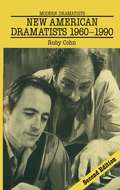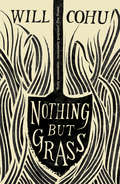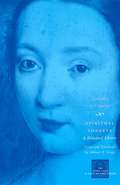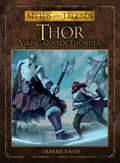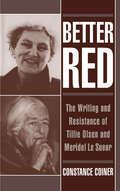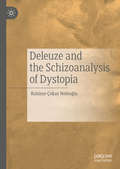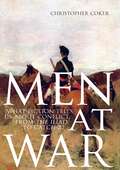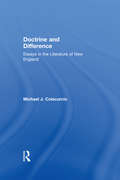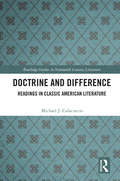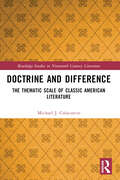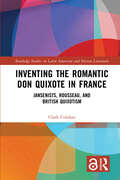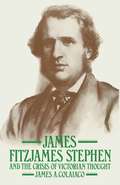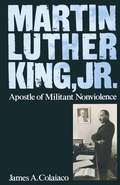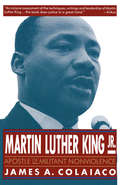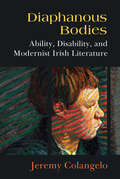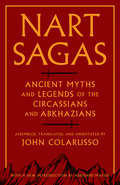- Table View
- List View
New American Dramatists 1960–1990 (Modern Dramatists)
by Ruby CohnIn the second edition of her New American Dramatists Ruby Cohn carries her panoramic survey to 1990. Not only does she augment the existing chapters on Broadway, off-Broadway, and off-off-Broadway, but she adds new material on women playwrights as well as Asian-American dramatists. With the emergence of David Mamet and Sam Shepard as major playwrights, she contrasts them for mutual illumination.
Nothing But Grass
by Will CohuIn the summer of 1875, two travellers walk south across the Lincolnshire Wolds to a village riven with dark secrets.When Norman Tanner kills his workmate on a cold February morning a century later, he thinks he’s got away with murder. But Norman doesn’t know about the workmate’s girlfriend, or the child that will come back to haunt him; and how he is caught up in a story that stretches back to that Victorian summer. For some in the village of Southby and its nearby grand estate, man is master of his fate, and the world is full of meaning; for others there is nothing but grass.
Spiritual Sonnets: A Bilingual Edition (The Other Voice in Early Modern Europe)
by Gabrielle de CoignardBorn into a wealthy family in Toulouse, Gabrielle de Coignard (ca. 1550-86) married a prominent statesman in 1570. Widowed three years later, with two young daughters to raise, Coignard turned to writing devotional verse to help her cope with her practical and spiritual struggles. Spiritual Sonnets presents the first English translation of 129 of Coignard's highly autobiographical poems, giving us a startlingly intimate view into the life and mind of this Renaissance woman. The sonnets are all written "in the shadow of the Cross" and include elegies, penitential lyrics, Biblical meditations, and more. Rich with emotion, Coignard's poems reveal anguished moments of loneliness and grief as well as ecstatic experiences of mystical union. They also reveal her mastery of sixteenth-century literary conventions and spiritual traditions. This edition, printed in bilingual format with Melanie E. Gregg's translations facing the French originals, will be welcomed by teachers and students of poetry, French literature, women's studies, and religious and Renaissance studies.
Spiritual Sonnets: A Bilingual Edition (The Other Voice in Early Modern Europe)
by Gabrielle de CoignardBorn into a wealthy family in Toulouse, Gabrielle de Coignard (ca. 1550-86) married a prominent statesman in 1570. Widowed three years later, with two young daughters to raise, Coignard turned to writing devotional verse to help her cope with her practical and spiritual struggles. Spiritual Sonnets presents the first English translation of 129 of Coignard's highly autobiographical poems, giving us a startlingly intimate view into the life and mind of this Renaissance woman. The sonnets are all written "in the shadow of the Cross" and include elegies, penitential lyrics, Biblical meditations, and more. Rich with emotion, Coignard's poems reveal anguished moments of loneliness and grief as well as ecstatic experiences of mystical union. They also reveal her mastery of sixteenth-century literary conventions and spiritual traditions. This edition, printed in bilingual format with Melanie E. Gregg's translations facing the French originals, will be welcomed by teachers and students of poetry, French literature, women's studies, and religious and Renaissance studies.
Spiritual Sonnets: A Bilingual Edition (The Other Voice in Early Modern Europe)
by Gabrielle de CoignardBorn into a wealthy family in Toulouse, Gabrielle de Coignard (ca. 1550-86) married a prominent statesman in 1570. Widowed three years later, with two young daughters to raise, Coignard turned to writing devotional verse to help her cope with her practical and spiritual struggles. Spiritual Sonnets presents the first English translation of 129 of Coignard's highly autobiographical poems, giving us a startlingly intimate view into the life and mind of this Renaissance woman. The sonnets are all written "in the shadow of the Cross" and include elegies, penitential lyrics, Biblical meditations, and more. Rich with emotion, Coignard's poems reveal anguished moments of loneliness and grief as well as ecstatic experiences of mystical union. They also reveal her mastery of sixteenth-century literary conventions and spiritual traditions. This edition, printed in bilingual format with Melanie E. Gregg's translations facing the French originals, will be welcomed by teachers and students of poetry, French literature, women's studies, and religious and Renaissance studies.
Thor: Viking God Of Thunder (Myths And Legends Ser. #5)
by Miguel Coimbra Graeme DavisIn the stories of the ancient Vikings, Thor is a warrior without equal, who wields his mighty hammer in battles against trolls, giants, and dragons. He is the god of storms and thunder, who rides to war in a chariot pulled by goats, and who is fated to fall in battle with the Midgard Serpent during Ragnarok, the end of all things. This book collects the greatest myths and legends of the thunder god, while also explaining their historical context and their place in the greater Norse mythology. It also covers the history of Thor as a legendary figure, how he was viewed by different cultures from the Romans to the Nazis, and how he endures today as a popular heroic figure.
Better Red: The Writing and Resistance of Tillie Olsen and Meridel Le Sueur
by Constance CoinerBetter Red is an interdisciplinary study addressing the complicated intersection of American feminism and the political left as refracted in Tillie Olsen's and Meridel Le Sueur's lives and literary texts. The first book-length study to explore these feminist writers' ties to the American Communist Party, it contributes to a reenvisioning of 1930s U.S. Communism as well as to efforts to promote working-class writing as a legitimate category of literary analysis. At once loyal members of the male-dominated Communist party and emerging feminists, Olsen and Le Sueur exhibit in their writing tendencies both toward and away from Party tenets and attitudes--at points subverting formalist as well as orthodox Marxist literary categories. By producing working-class discourse, Olsen and Le Sueur challenge the bourgeois assumptions--often masked as classless and universal--of much canonical literature; and by creating working-class women's writing, they problematize the patriarchal nature of the Left and the masculinist assumptions of much proletarian literature, anticipating the concerns of "second wave" feminists a generation later.
Deleuze and the Schizoanalysis of Dystopia
by Rahime Çokay NebioğluThis book offers an insightful history of dystopian literature, integrating it within the conceptual schemas of Deleuze and Guattari. Unlike earlier examples of dystopia which depict representations of a possible future that is remarkably worse than present society, contemporary dystopia often tends to portray an almost allegorical re-presentation of present society. Tracing dystopia’s shift from transcendence towards immanence with the rise of late neoliberal capitalism and control-societies, Çokay Nebioğlu skilfully constructs a new taxonomy of dystopian fiction to address this changing dynamic. Accompanied by a subtle exploration of earlier and later examples of the genre by George Orwell, Aldous Huxley, Suzanne Collins, Veronica Roth, William Gibson, Max Barry, Dave Eggers, Cindy Pon, and Tahsin Yücel along with rich and nuanced analysis of China Mieville’s Perdido Street Station and Margaret Atwood’s MaddAddam trilogy, the book seeks not only to track the transformation of dystopia in light of worldwide cultural, political and economic transformation, but also to conduct a schizoanalytic reading of dystopia, thus opening up an exciting field of enquiry for Deleuzian scholars.
Men At War: What Fiction Tells us About Conflict, From The Iliad to Catch-22
by Christopher CokerSince Achilles first stormed into our imagination, literature has introduced its readers to truly unforgettable martial characters. In Men at War, Christopher Coker discusses some of the most famous of these fictional creations and their impact on our understanding of war and masculinity. Grouped into five archetypes-warriors, heroes, villains, survivors and victims-these characters range across 3000 years of history, through epic poems, the modern novel and one of the twentieth century's most famous film scripts. Great authors like Homer and Tolstoy show us aspects of reality invisible except through a literary lens, while fictional characters such as Achilles and Falstaff, Robert Jordan and Jack Aubrey, are not just larger than life; they are life's largeness-and this is why we seek them out. Although the Greeks knew that the lovers, wives and mothers of soldiers are the chief victims of battle, for the combatants, war is a masculine pursuit. Each of Coker's chapters explores what fiction tells us about war's appeal to young men and the way it makes- and breaks-them. The existential appeal of war too is perhaps best conveyed in fictional accounts, and these too are scrutinized by the author.
Men At War: What Fiction Tells us About Conflict, From The Iliad to Catch-22
by Christopher CokerSince Achilles first stormed into our imagination, literature has introduced its readers to truly unforgettable martial characters. In Men at War, Christopher Coker discusses some of the most famous of these fictional creations and their impact on our understanding of war and masculinity. Grouped into five archetypes-warriors, heroes, villains, survivors and victims-these characters range across 3000 years of history, through epic poems, the modern novel and one of the twentieth century's most famous film scripts. Great authors like Homer and Tolstoy show us aspects of reality invisible except through a literary lens, while fictional characters such as Achilles and Falstaff, Robert Jordan and Jack Aubrey, are not just larger than life; they are life's largeness-and this is why we seek them out. Although the Greeks knew that the lovers, wives and mothers of soldiers are the chief victims of battle, for the combatants, war is a masculine pursuit. Each of Coker's chapters explores what fiction tells us about war's appeal to young men and the way it makes- and breaks-them. The existential appeal of war too is perhaps best conveyed in fictional accounts, and these too are scrutinized by the author.
Doctrine and Difference: Essays in the Literature of New England
by Michael J. ColacurcioFirst published in 1997. Routledge is an imprint of Taylor & Francis, an informa company.
Doctrine and Difference: Essays in the Literature of New England
by Michael J. ColacurcioFirst published in 1997. Routledge is an imprint of Taylor & Francis, an informa company.
Doctrine and Difference: Readings in Classic American Literature (Routledge Studies in Nineteenth Century Literature #2)
by Michael J. ColacurcioDoctrine and Difference: Readings in Classic American Literature aims to expand and deepen the inquiry begun in the volume from 2007. Beginning with an essay on the avowedly Puritan poetry of Anne Bradstreet and ending with two not-quite-secular novels from late in the 19th century, this volume seeks to uncover the religious and philosophical meanings deeply embedded in so much of 19th century American literature, and then, importantly, to identify and analyze the techniques by which the "doctrines" are differentiated into imaginative literature. Poe, Emerson, Thoreau, Hawthorne, Melville—and yes, even Howells and James—are driven by powerful thematic intentions. But they do not preach: they dramatize. And, as they talk their way through their existential issues, they often talk to one another: yes, no, maybe, ok but not so fast. Stressing the idea of a shared, poet-Puritan inheritance, the new Doctrine and Difference means to re-confirm the vitality of literary history and, in particular, the importance of reading the classic texts of American literature in context and in relation.
Doctrine and Difference: Readings in Classic American Literature (Routledge Studies in Nineteenth Century Literature #2)
by Michael J. ColacurcioDoctrine and Difference: Readings in Classic American Literature aims to expand and deepen the inquiry begun in the volume from 2007. Beginning with an essay on the avowedly Puritan poetry of Anne Bradstreet and ending with two not-quite-secular novels from late in the 19th century, this volume seeks to uncover the religious and philosophical meanings deeply embedded in so much of 19th century American literature, and then, importantly, to identify and analyze the techniques by which the "doctrines" are differentiated into imaginative literature. Poe, Emerson, Thoreau, Hawthorne, Melville—and yes, even Howells and James—are driven by powerful thematic intentions. But they do not preach: they dramatize. And, as they talk their way through their existential issues, they often talk to one another: yes, no, maybe, ok but not so fast. Stressing the idea of a shared, poet-Puritan inheritance, the new Doctrine and Difference means to re-confirm the vitality of literary history and, in particular, the importance of reading the classic texts of American literature in context and in relation.
Doctrine and Difference: The Thematic Scale of Classic American Literature (Routledge Studies in Nineteenth Century Literature)
by Michael J. ColacurcioDoctrine and Difference: The Thematic Scale of Classic American Literature aims to expand and deepen our knowledge into the inquiry of “contextual historicism,” observing writers of the American nineteenth century, and their vastly differing approaches to perceptions such as race, gender, and national identity. Ranging from the religious acuities of the first American Puritans to the more secularized literary awakening of the American Renaissance and into late-century texts that deliberately resist the limits of received religious and political opinion, this volume seeks to uncover a history of human thought within classic American Literature. This volume critically observes these survivable works of literature, presenting insight into the “difference” made by conversation, dispute, and dramatized self-doubt within novels and poems of the historical past.
Doctrine and Difference: The Thematic Scale of Classic American Literature (Routledge Studies in Nineteenth Century Literature)
by Michael J. ColacurcioDoctrine and Difference: The Thematic Scale of Classic American Literature aims to expand and deepen our knowledge into the inquiry of “contextual historicism,” observing writers of the American nineteenth century, and their vastly differing approaches to perceptions such as race, gender, and national identity. Ranging from the religious acuities of the first American Puritans to the more secularized literary awakening of the American Renaissance and into late-century texts that deliberately resist the limits of received religious and political opinion, this volume seeks to uncover a history of human thought within classic American Literature. This volume critically observes these survivable works of literature, presenting insight into the “difference” made by conversation, dispute, and dramatized self-doubt within novels and poems of the historical past.
Inventing the Romantic Don Quixote in France: Jansenists, Rousseau, and British Quixotism (Routledge Studies in Latin American and Iberian Literature)
by Clark ColahanCervantes’ now mythical character of Don Quixote began as a far different figure than the altruistic righter of wrongs we know today. The transformation from mad highway robber to secular saint took place in the Romantic Era, but how and where it began has just begun to be understood. Germany and England played major roles, but, contrary to earlier literary historians, Pascal, Racine, Rousseau and the Jansenists scooped Henry and Sarah Fielding. Jansenism, a persecuted puritanical and intellectual movement linked to Pascal, identified itself with Don Quixote’s virtues, excused his vices, and wrote a game-changing sequel mediated by the transformative powers of a sorcerer from Commedia dell’Arte. As an early Romantic, Rousseau was attracted to the hero’s fertile imagination and tender love for Dulcinea, foregrounding the would-be knight’s quest in a play and his best-selling novel, Julie. Sarah Fielding reacted similarly, basing her utopian novel David Simple on the Jansenist concept of quixotic trust in others. Colahan here reproduces and explains for the first time the extremely rare original illustrations of the French sequel to Cervantes’ novel, and documents the fortunes in French culture of the magician at the heart of the Romantic Quixote.
Inventing the Romantic Don Quixote in France: Jansenists, Rousseau, and British Quixotism (Routledge Studies in Latin American and Iberian Literature)
by Clark ColahanCervantes’ now mythical character of Don Quixote began as a far different figure than the altruistic righter of wrongs we know today. The transformation from mad highway robber to secular saint took place in the Romantic Era, but how and where it began has just begun to be understood. Germany and England played major roles, but, contrary to earlier literary historians, Pascal, Racine, Rousseau and the Jansenists scooped Henry and Sarah Fielding. Jansenism, a persecuted puritanical and intellectual movement linked to Pascal, identified itself with Don Quixote’s virtues, excused his vices, and wrote a game-changing sequel mediated by the transformative powers of a sorcerer from Commedia dell’Arte. As an early Romantic, Rousseau was attracted to the hero’s fertile imagination and tender love for Dulcinea, foregrounding the would-be knight’s quest in a play and his best-selling novel, Julie. Sarah Fielding reacted similarly, basing her utopian novel David Simple on the Jansenist concept of quixotic trust in others. Colahan here reproduces and explains for the first time the extremely rare original illustrations of the French sequel to Cervantes’ novel, and documents the fortunes in French culture of the magician at the heart of the Romantic Quixote.
Martin Luther King, Jr.: Apostle of Militant Nonviolence
by James A ColaiacoIn this exemplary work of scholarly synthesis the author traces the course of events from the emergence of Martin Luther King, Jr. as a national black spokesman during the Montgomery bus boycott to his radical critique of American society and foreign policy during the last years of his life. He also provides the first in-depth analysis of King's famous Letter from Birmingham Jail - a manifesto of the American civil rights movement and an eloquent defence of non-violent protest.
Martin Luther King, Jr.: Apostle of Militant Nonviolence
by James A. ColaiacoIn this exemplary work of scholarly synthesis the author traces the course of events from the emergence of Martin Luther King, Jr. as a national black spokesman during the Montgomery bus boycott to his radical critique of American society and foreign policy during the last years of his life. He also provides the first in-depth analysis of King's famous Letter from Birmingham Jail - a manifesto of the American civil rights movement and an eloquent defence of non-violent protest.
Diaphanous Bodies: Ability, Disability, and Modernist Irish Literature (Corporealities: Discourses Of Disability)
by Jeremy ColangeloDiaphanous Bodies: Ability, Disability, and Modernist Irish Literature examines ability, as a category of embodiment and embodied experience, and in the process opens up a new area of inquiry in the growing field of literary disability studies. It argues that the construction of ability arises through a process of exclusion and forgetting, in which the depiction of sensory information and epistemological judgment subtly (or sometimes un-subtly) elide the fact of embodied subjectivity. The result is what Colangelo calls “the myth of the diaphanous abled body,” a fiction that holds that an abled body is one which does not participate in or situate experience. The diaphanous abled body underwrites the myth that abled and disabled constitute two distinct categories of being rather than points on a constantly shifting continuum. In any system of marginalization, the dominant identity always sets itself up as epistemologically and experientially superior to whichever group it separates itself from. Indeed, the norm is always most powerful when it is understood as an empty category or a view from nowhere. Diaphanous Bodies explores the phantom body that underwrites the artificial dichotomy between abled and disabled, upon which the representation of embodied experience depends.
Nart Sagas: Ancient Myths and Legends of the Circassians and Abkhazians
by John Colarusso Adrienne MayorThe sagas of the ancient Narts are to the Caucasus what Greek mythology is to Western civilization. This book presents, for the first time in the West, a wide selection of these fascinating myths preserved among four related peoples whose ancient cultures today survive by a thread. In ninety-two straightforward tales populated by extraordinary characters and exploits, by giants who humble haughty Narts, by horses and sorceresses, Nart Sagas from the Caucasus brings these cultures to life in a powerful epos. In these colorful tales, women, not least the beautiful temptress Satanaya, the mother of all Narts, are not only fertility figures but also pillars of authority and wisdom. In one variation on a recurring theme, a shepherd, overcome with passion on observing Satanaya bathing alone, shoots a "bolt of lust" that strikes a rock--a rock that gives birth to the Achilles-like Sawseruquo, or Sosruquo. With steely skin but tender knees, Sawseruquo is a man the Narts come to love and hate. Despite a tragic history, the Circassians, Abazas, Abkhaz, and Ubykhs have retained the Nart sagas as a living tradition. The memory of their elaborate warrior culture, so richly expressed by these tales, helped them resist Tsarist imperialism in the nineteenth century, Stalinist suppression in the twentieth, and has bolstered their ongoing cultural journey into the post-Soviet future. Because these peoples were at the crossroads of Eurasia for millennia, their myths exhibit striking parallels with the lore of ancient India, classical Greece, and pagan Scandinavia. The Nart sagas may also have formed a crucial component of the Arthurian cycle. Notes after each tale reveal these parallels; an appendix offers extensive linguistic commentary. With this book, no longer will the analysis of ancient Eurasian myth be possible without a close look at the Nart sagas. And no longer will the lover of myth be satisfied without the pleasure of having read them. Excerpts from the Nart sagas "The Narts were a tribe of heroes. They were huge, tall people, and their horses were also exuberant Alyps or Durduls. They were wealthy, and they also had a state. That is how the Narts lived their lives. . . ." "The Narts were courageous, energetic, bold, and good-hearted. Thus they lived until God sent down a small swallow. . . ." "The Narts were very cruel to one another. They were envious of one another. They disputed among themselves over who was the most courageous. But most of all they hated Sosruquo. . . . A rock gave birth to him. He is the son of a rock, illegally born a mere shepherd's son. . . ."In a new introduction, folklorist Adrienne Mayor reflects on these tales both in terms of the fascinating warrior culture they depict and the influence they had on Greco-Roman mythology.
Nart Sagas: Ancient Myths and Legends of the Circassians and Abkhazians
by John Colarusso Adrienne MayorThe sagas of the ancient Narts are to the Caucasus what Greek mythology is to Western civilization. This book presents, for the first time in the West, a wide selection of these fascinating myths preserved among four related peoples whose ancient cultures today survive by a thread. In ninety-two straightforward tales populated by extraordinary characters and exploits, by giants who humble haughty Narts, by horses and sorceresses, Nart Sagas from the Caucasus brings these cultures to life in a powerful epos. In these colorful tales, women, not least the beautiful temptress Satanaya, the mother of all Narts, are not only fertility figures but also pillars of authority and wisdom. In one variation on a recurring theme, a shepherd, overcome with passion on observing Satanaya bathing alone, shoots a "bolt of lust" that strikes a rock--a rock that gives birth to the Achilles-like Sawseruquo, or Sosruquo. With steely skin but tender knees, Sawseruquo is a man the Narts come to love and hate. Despite a tragic history, the Circassians, Abazas, Abkhaz, and Ubykhs have retained the Nart sagas as a living tradition. The memory of their elaborate warrior culture, so richly expressed by these tales, helped them resist Tsarist imperialism in the nineteenth century, Stalinist suppression in the twentieth, and has bolstered their ongoing cultural journey into the post-Soviet future. Because these peoples were at the crossroads of Eurasia for millennia, their myths exhibit striking parallels with the lore of ancient India, classical Greece, and pagan Scandinavia. The Nart sagas may also have formed a crucial component of the Arthurian cycle. Notes after each tale reveal these parallels; an appendix offers extensive linguistic commentary. With this book, no longer will the analysis of ancient Eurasian myth be possible without a close look at the Nart sagas. And no longer will the lover of myth be satisfied without the pleasure of having read them. Excerpts from the Nart sagas "The Narts were a tribe of heroes. They were huge, tall people, and their horses were also exuberant Alyps or Durduls. They were wealthy, and they also had a state. That is how the Narts lived their lives. . . ." "The Narts were courageous, energetic, bold, and good-hearted. Thus they lived until God sent down a small swallow. . . ." "The Narts were very cruel to one another. They were envious of one another. They disputed among themselves over who was the most courageous. But most of all they hated Sosruquo. . . . A rock gave birth to him. He is the son of a rock, illegally born a mere shepherd's son. . . ."In a new introduction, folklorist Adrienne Mayor reflects on these tales both in terms of the fascinating warrior culture they depict and the influence they had on Greco-Roman mythology.
